Latest advances in health care cleaning and disinfection chemicals
The latest cleaning chemicals for hospitals are formulated to not only clean and disinfect, but to counteract health care-associated infection (HAI)-causing pathogens and other emerging threats. They also are formulated to balance efficiency and surface compatibility. Ease of use is another important quality. It’s all about effectiveness, speed, safety and processes that reduce the risk of infection.
Environmental services professionals are focused on providing a safe environment of care. To accomplish this in a cost-effective manner, they need to find disinfectants that are broad-spectrum, fast-acting, stay wet for the required dwell time, and are safe and easy to use.
You may also like |
| Advances in floor cleaning equipment |
| A look at automated disinfection systems |
| Furnishings and materials to aid infection prevention |
|
|
One of the big challenges related to disinfectant chemical products in hospitals is achieving an appropriate balance between efficacy and surface compatibility. Effectiveness is critical to reducing the risk of infection, but appropriate care must be taken to protect surfaces and equipment from damage.
“There are two key considerations when it comes to surface compatibility: aesthetic issues, such as residue, and corrosion. All disinfectants can cause surface compatibility issues if they are used improperly. The key is to understand potential challenges and to select products that minimize them,” says Laurie Rabens, senior product manager, Clorox Healthcare, Pleasanton, Calif.
More chemical disinfection products are available now than ever before. However, the range of formulations that have been tested and approved for specific devices is limited, due to the effort and cost associated with validation testing, adds Elise Tordella, vice president of marketing, PDI Healthcare, Orangeburg, N.Y.
Another challenge for hospitals involves choosing the right disinfectant for the job and training staff to use it properly, with special consideration given to dwell time. For a disinfectant to be effective, it needs to sit wet on a surface for a certain length of time. This ensures that the disinfectant is in contact with the microorganism long enough to kill it.
“We often see cleaning staff apply a disinfectant and then immediately wipe it down without letting it stay wet for the required dwell time,” says Benjamin J. Oberle, health care channel marketer, 3M, St. Paul, Minn. “This misstep is often attributed to the pressures of cleaning and the need to quickly turn over a room for the next patient. However, there are products on the market that increase cleaning efficiency while offering a decreased dwell time.”
Indeed, training and retention of skills is key to the everyday use of cleaning chemicals. “Studies show that training is the No. 1 issue in helping to prevent HAIs. Those studies also show that the positive effects of training in health care facilities start to diminish after 90 days, and people go back to their old habits,” says Jason Welch, microbiologist, Spartan Chemical Co., Maumee, Ohio.
To address this issue, Spartan Chemical has added a health care module to its CleanCheck program that addresses the short- and long-term training needs of hospitals while providing exam-supported certification. “In addition, we recommend that initial staff training is reinforced through verification and validation of cleaning procedures on a routine basis. These validation checks are not done punitively, but rather to identify areas where they can improve, creating a safer environment for both the patient and the cleaning staff,” Welch says.
Because of the Ebola scare and other more recent biological threats, hospitals are taking a closer look at their disinfectant products and cleaning processes. Health care facilities need to implement infection control strategies that can address a wide range of threats, including the risk posed by antibiotic-resistant organisms such as Candida auris, an emerging multidrug-resistant, yeast-causing invasive HAI with high mortality.
“Recently, the Centers for Disease Control and Prevention (CDC) revised its recommendation for C. auris infection-control measures to include thorough daily and after-discharge cleaning of C. auris patient rooms using Environmental Protection Agency (EPA)-registered hospital disinfectants that are effective against Clostridium difficile. The previous recommendation was to use a hospital disinfectant effective against fungi,” Rabens says.
In light of these challenges, many health care facilities are opting to expand the use of sporicidal disinfectants that offer broad-spectrum efficacy for a more comprehensive approach to environmental infection control.
Cleaning innovations
Among a host of cleaning chemicals introduced to the hospital market, Sealed Air’s Diversey Care division, Charlotte, N.C., recently launched Oxivir 1 ready-to-use disinfectant cleaner and wipes. Powered by accelerated hydrogen peroxide, it is effective against a broad range of bacteria, enveloped and non-enveloped viruses, tuberculosis and fungi in one minute or less.
“The Oxivir one-step solution requires no personal protective equipment (PPE) and is compatible with common health care surfaces and equipment. It also has a Category IV safety rating, which means it is nonirritating to the skin, eyes and respiratory tracts,” says Carolyn Cooke, vice president of the North America health care sector.
Clorox Healthcare recently enhanced two of its health care disinfectants. One, Clorox Healthcare hydrogen peroxide cleaner disinfectant wipes and sprays, offers fast non-bleach disinfecting times for more than 40 microorganisms and is noncorrosive to hard and soft surfaces commonly found in health care facilities. The spray and wipes also are formulated to improve patient and staff comfort, and have no harsh chemical fumes or odors.
The other is Clorox Healthcare Bleach Germicidal Wipes, which kill 58 microorganisms (including C. difficile spores) in three minutes or less. They have been optimized for extended use in health care facilities, offering improved surface compatibility and less residue compared with conventional bleach disinfectant wipes.
Ecolab Inc., St. Paul, Minn., has unveiled the OxyCide Daily Disinfectant Cleaner, which kills 33 organisms in five minutes or less, including C. difficile spores in three minutes. It also meets CDC guidance for cleaning and disinfecting against emerging pathogens such as C. auris. “OxyCide is formulated for daily use by environmental services teams, which gives patients daily preventive protection against C. difficile and other organisms of concern. Compatible with most health care surfaces, OxyCide dries without leaving residue,” says Hank Carbone, senior marketing manager, Ecolab’s health care division.
PDI Healthcare has introduced Sani-Cloth Prime Germicidal Disposable Wipe and Sani-Prime Germicidal Spray, an EPA-approved, intermediate-level disinfectant that achieves a one-minute overall contact time for a broad spectrum of microorganisms that are prevalent in hospitals. “Sani-Cloth Prime wipes and Sani-Prime spray products are effective against 54 microorganisms, including 17 multidrug-resistant bacteria such as methicillin-resistant Staphylococcus aureus, vancomycin-resistant Enterococcus and carbapenem-resistant Enterobacteriaceae. They also are compatible across a wide variety of surfaces and equipment,” Tordella says.
Spartan Chemical Co. offers Diffense, an EPA-registered, broad-spectrum cleaner-disinfectant that has been proven to kill C. difficile spores. Effective against a wide range of bacteria and viruses and offering less than one-minute disinfection, Diffense is formulated for areas where the prevention of HAIs is critical.
3M C. diff Solution Tablets provide an effective alternative to bleach and peracetic acid disinfectants. They are EPA-registered to kill C. difficile spores in four minutes and are effective against Norovirus. They feature a National Fire Protection Association rating of 0,0,0 with no PPE required at use dilution. The product can be applied with a cloth, wipe, mop or coarse trigger sprayer, and will not bind to common wiping media.
The growth of ultraviolet (UV) disinfecting technologies has had a minimal effect on manufacturers of cleaning chemicals. In fact, the two product categories are complementary. Experts agree that UV devices are excellent resources for health care facilities. It’s important to remember, though, that they are designed to supplement, not replace, manual surface cleaning and disinfection with EPA-registered disinfectants.
For example, Sealed Air’s Diversey Care division now offers UV disinfection technology along with its cleaning chemicals. “We see this as a complementary, additive technology to manual cleaning and disinfection to further reduce the risk of HAIs. The key to unlocking this added assurance is the ability to integrate these UV devices into the standard cleaning and disinfection processes conducted by environmental services teams,” Cooke says.
Green and clean
Green cleaning is another area of interest to manufacturers that supply the nation’s hospitals. Experts see a trend toward environmental services managers’ wanting to use more sustainable cleaning products. While not willing to give up performance, they will purchase products that are more environmentally responsible.
This has always been an interesting area of discussion, according to Carbone. “In the U.S., the only eco-label certification that a disinfectant can achieve is Safer Choice through the EPA’s Antimicrobial Pesticide Pilot Program. All disinfectant products currently on this list are ready-to-use solutions that may not fit a hospital’s environmental services work practices. This is an evolving area and one to watch going forward as manufacturers continue to work with the EPA,” he says.
The concept of green cleaning actually can complicate the disinfection aspect of infection control, according to Welch. “Disinfection is the destruction of a microorganism; therefore, disinfection by nature is not a green process. Disinfectants are EPA-registered [antimicrobial] pesticides and have strict data requirements. Currently, the EPA does not allow any third-party green logos on registered disinfectants,” he says. “If a customer wants to be green, he or she has to focus on cleaning things first and then do a risk assessment for areas that may be a source of environmental contamination for a transferable infection.”
PDI Healthcare is looking for innovative ways to deliver products made from renewable sources to help institutions reduce their waste streams. For example, the company recently introduced single-use towels made from 100 percent viscose fibers for use in hospital food service facilities. The towels are 100 percent compostable and certified by the Biodegradable Products Institute.
The growth of smaller, off-site health care facilities has not affected new product offerings or the use of cleaning chemicals to a great extent, beyond volume and packaging. Many off-site facilities have needs similar to those of larger locations, but may need them packaged in smaller-quantity offerings or in more portable formats. “This has generated interest in portable solutions that are ready to use, and in products that don’t require dispensing or specialized training,” Cooke says.
Looking ahead
“In recent years, we’ve seen new cleaning chemicals with short contact times against a broad spectrum of organisms, including spores. We expect this trend to continue, with contact times getting shorter and the breadth of efficiency increasing,” says Carbone. He expects material compatibility to be a focus, with more emphasis on simplifying use, thereby making it easier for hospitals to train their staff and integrate new products.
Oberle says hospitals must look at a total cleaning strategy that addresses other factors, including dust control and cross-contamination. “Health care facilities are paying more attention to the process of cleaning, while also focusing on product selection,” he says. “Nevertheless, disinfectant manufacturers will continue to look for solutions that offer a broader kill spectrum and decreased dwell time.”
Neal Lorenzi is a freelance writer based in Mundelein, Ill.
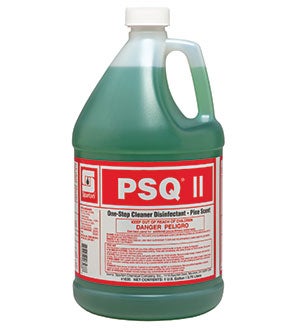
Hard hitter
PSQ II is a one-step cleaner designed for disinfecting hard, nonporous surfaces. It inhibits the growth of mold and mildew and the odors caused by them. Spartan Chemical Co.

One and done
Oxivir wipes offer effective, sustainable cleaning and disinfection in one minute or less. Diversey Care
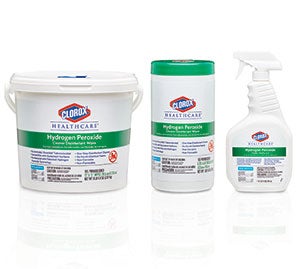
Easy alternative
These hydrogen peroxide cleaner disinfectant wipes and sprays offer fast, non-bleach disinfecting times for more than 40 microorganisms. Clorox Healthcare
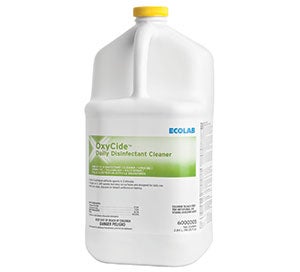
Quick fix
OxyCide Daily Disinfectant Cleaner kills Clostridium difficile spores in three minutes. Ecolab
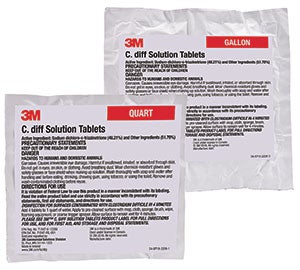
Certified clean
These Clostridium difficile solution tablets are EPA-registered to kill C. difficile spores in four minutes and are effective against Norovirus. 3M
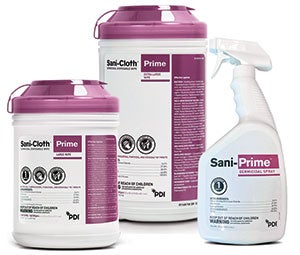
All covered
The Sani-Cloth Prime family of products is effective against 54 microorganisms, including 17 multidrug-resistant bacteria. PDI Healthcare




